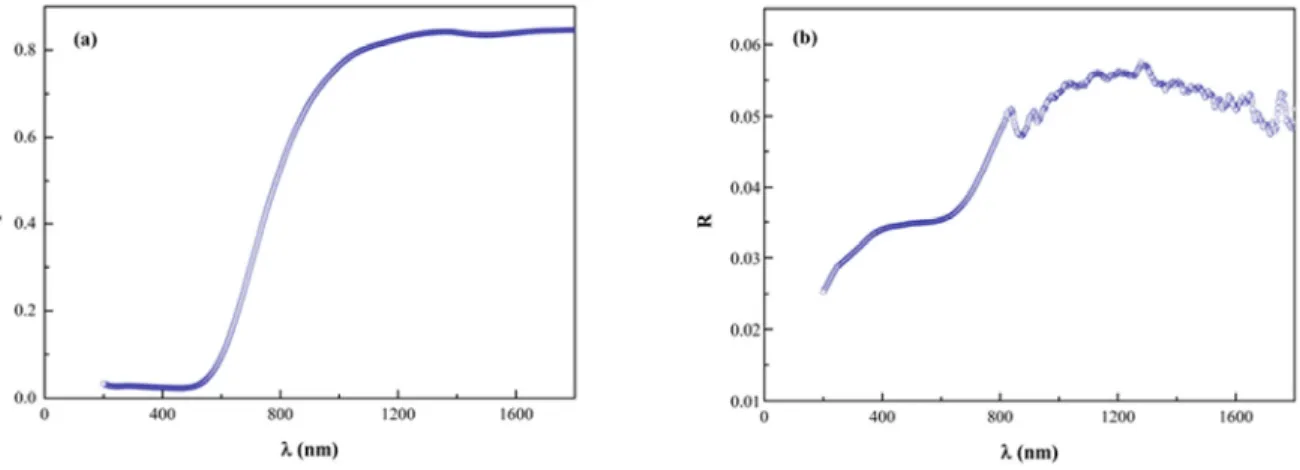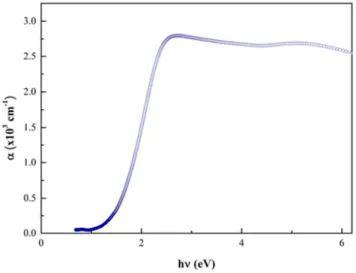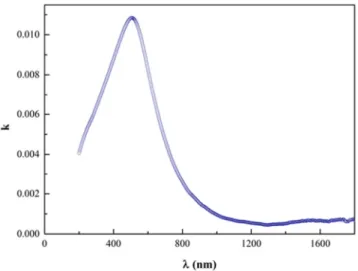ScienceDirect
Materials Today: Proceedings 18 (2019) 1972–1977 www.materialstoday.com/proceedings
2214-7853 © 2019 Elsevier Ltd. All rights reserved.
Selection and/or Peer-review under responsibility of INTERNATIONAL CONGRESS ON SEMICONDUCTOR MATERIALS AND DEVICES.
ICSMD-2017
Some optical properties of melanin thick film
Ü. Akın
a,*, İ. Çelik
b, Ç. Avcı
b, N. Tuğluoğlu
cand Ö. F. Yüksel
aaDepartment of Physics, Faculty of Science, Selçuk University, Konya 42075, TURKEY
bDepartment of Histology and Embryology, Faculty of Veterinary Medicine, Selçuk University, Konya 42075, TURKEY cDepartment of Energy Systems Engineering, Faculty of Engineering, Giresun University, Giresun 28200, TURKEY
Abstract
The melanin obtained from brown-black sheep wool was prepared in the form of thick film by using drop casting method on the soda-lime glass substrate. The optical properties of the melanin thick film have been investigated by means of the optical measurements. It was observed that the thick film showed high transmittance value nearly up to 84 % in the IR spectral region and it showed very high absorbance in both UV and visible regions. From standard optical analysis, it was observed that melanin thick film had the properties of the semiconductors with indirect band gap, and the band gap energy value was found as 1.24 eV. Also, it was seen that calculated refractive index of the melanin thick film varies between 1.37 and 1.63 throughout the spectral region considered.
© 2019 Elsevier Ltd. All rights reserved.
Selection and/or Peer-review under responsibility of INTERNATIONAL CONGRESS ON SEMICONDUCTOR MATERIALS AND DEVICES.
Keywords: Melanin Thick Film; Optical Properties
1. Introduction
Depending on the chemical composition and structural difference, the melanins classified into eumelanin, pheomelanin and neuromelanin are a class of bio-functional macromolecules and are commonly found in living organisms such as hair, eye, human skin [1-3]. Due to their good optical and electrical properties, in recent years, the melanins have become a potential material for many areas, especially organic solar cells, bio-devices and other novel electronic devices [2]. Having strong broad-band UV and visible optical absorption and relatively high electrical conductivity has provided melanins act as organic semiconductors and thus have made them take an important place in organic semiconductor technology [3].
* Corresponding author. Tel.: +90.332.223 34 95; fax: +90.332.241 24 99.
The melanin which has different forms is a dark brown pigment. Among its forms, eumelanin which is a black brown pigment containing nitrogen (sulfur-free) is found in black hair, skin and retina, and is broad band ultra-violet and visible light absorber [2,4,5]. Yellow or reddish brown sulfur-containing pheomelanin is present in red hair and red feathers [5-8]. Although most natural melanins are a mixture of both pigments, due to its potential applications of the eumelanin as a bioelectronic material, there is more information about the structural, optical and electrical properties of eumelanin than on those of pheomelanin in literature [9]. Optical measurements of melanins are usually dependent on their absorption characteristics, but this brings many limitation because melanins have no distinctive absorption peaks that allow distinguishing them from other pigments [9]. Many researchers [10-12] made discriminant analyses based on spectroscopic measurements and saw that absorption properties of eumelanin and pheomelanin have not significantly different spectra [9,13]. Particularly, the absorption spectrum of eumelanin with the increasing photon energy from the NIR to the UV, is similar to that of an amorphous semiconductor [2].
The optical properties of melanins play an important role in skin photo-protection [14]. The melanins strongly absorb short wavelengths of ultraviolet radiation and show a natural resistance to skin cancer that has been exposed to ultraviolet radiation. Therefore, understanding the fundamental optical properties of biological materials is imperative and it is essential to have a thorough knowledge for many applications, especially medical applications [13]. In additional to their optical properties, electrical properties are also important. In particular, eumelanin shows significant electrical and photoconductivity, which depend strongly on the hydration state [15]. However, despite being investigated for a long time, the macromolecular structure and the charge carrier mechanism of eumelanin are still poorly understood [15]. Therefore, researches on eumelanin are continued, especially for applications in electronic devices.
In this study, the eumelanin pigment was isolated from a domestic sheep breed, Morkaraman sheep, with concentrated sulphuric acid treatment and purified with urea MNaOH solution. It was then prepared in the form of thick film and its optical properties were investigated. Absorption coefficient of prepared eumelanin thick film have been determined by standard optical analysis and its refractive index (n) and extinction coefficient (k), have been calculated.
2. Experimentals
2.1. Melanin extraction and purification process
Melanin, which is found in all organisms and has different types, is most commonly found as brown-black colored eumelanin and red-brown colored pheomelanin in humans and mammalians. In this present work, the eumelanin pigment was isolated from a domestic sheep breed, Morkaraman sheep, with concentrated sulphuric acid treatment and purified with urea MNaOH solution for 24 hours. 500 g of the wool immersed in distilled water three times and dried under warmed air flow. In order to extract the eumelanine, the dried wool was treated with concentrated sulphuric acid for 48 hours. Then, the extract was treated with urea solution in order to remove unwanted proteins. Increase of melanosome precipitates was assayed by intermittent light microscopic inspections. Following successive urea treatments high purity eumelanine extract was prepared. Eumelanine pigment was sedimented in acidic milieu. The precipitate dried under warmed air flow and powdered. After, the solution used to prepare the thick film was prepared (Fig.1).
2.2. Thick Film Preparation Process
The eumelanin obtained from brown-black sheep wool was prepared in the form of thick film by using drop casting method on the soda-lime glass substrate. The optical properties of the eumelanin thick film have been investigated by means of the optical measurements.
The transmittance and reflectance spectrum of prepared film were recorded by UV-VIS-NIR spectrometer (Jasco V-670 model) in a wide spectral range from 300 to 1800 nm. Also, the thickness measurement of eumelanin thick film was performed by using profilometer Veeco Dektak 150, and the thickness was determined approximately as 5730 nm.
Fig. 1. Extraction and purification process of eumelanin pigment. 3. Results and discussion
The experimental studies on the optical absorption of materials have great importance for examination the optically induced transitions and also for obtaining valuable information about the band structure and energy gap. Also, the transmittance or the reflectance spectrum for materials is the first optical response data that can give valuable first information about its electronic structure and optical behavior [16]. The measured spectral variations of transmittance and reflectance of the eumelanin thick film are depicted in Fig.2a and b, respectively. As it is seen in the Fig.2a, the film showed high transmittance nearly up to 84 % in the IR spectral region, and then a sudden drop has been observed at shorter wavelengths. This sudden drop indicate very high absorbance in the UV and visible region. And also, it was observed that it showed low reflectance throughout the spectral region considered (Fig.2b).
Fig. 2. Spectral variation of transmittance (a) and reflectance (b) of the eumelanin thick film.
The linear absorption coefficient (α) of prepared thick film has been calculated by using the transmittance and reflectance spectrum values of film from the relation [17]
= ln (1)
Fig. 3. Spectral variation of α versus λ of the eumelanin thick film.
In the transmittance spectra of films, overt sudden rises at short wavelengths correspond to the fundamental absorption thresholds of films. In the high absorption regime, which often termed as Tauc region ( 10 ), the absorption coefficient obeys a power law such as
= − (2) where is a constant, is the photon energy, is the band gap energy, and is an index which points out to the characteristics of transition involved and its value can be assumed as 1/2 and 2 for direct and indirect transitions, respectively [18].
In literature, the melanin thin films are assumed mostly as shown an indirect interband transition [5,6,19]. In this work, from the plotted graphics, it was observed that eumelanin thick film has an indirect band gap. As seen in the Fig. 4, an adequate linear portion has been obtained, and from its intercept to the energy axis, indirect band gap energy could be estimated. In this way, the band gap energy value of melanin thick film was found as 1.24 eV.
Complex refractive index of a material is a crucial optical parameter which designates its many physical properties [20],
= − (3)
Imaginary part of complex refractive index, the extinction coefficient , can be calculated directly from the absorption coefficient using the relation of = /4 . Fig. 5 shows the variation of the extinction coefficient of melanin thick film with the wavelength. As shown in Fig. 5, the value of the extinction coefficient is quite slightly varied in a wide spectral range starting from near-infrared to the visible region and has very small values throughout the spectral region considered. Also, it increases rapidly with decreasing wavelength at the onset of ultraviolet region as a result of absorbance increment and exhibits a peak nearly at 500 nm.
Fig. 5. The variations of the extinction coefficient with the wavelength.
On the other hand, the spectral variation of refractive index of the film is shown in the Fig. 6. The spectral variation of refractive index was calculated from the reflectance and the extinction coefficient values using the following relation [21-23],
= + − (4) From Fig. 6, it was seen that calculated refractive index of the eumelanin thick film varies between 1.37 and 1.63 overall the spectral region considered. Since the extinction coefficient is small, the spectral behavior of refractive index is almost similar to that of reflection spectrum as expected from the equation (4).
4. Conclusions
In this study, the eumelanin isolation and purification from Morkaraman sheep wool were successfully performed with acid and following urea treatment. Some optical constants of the eumelanin thick film obtained from brown-black sheep wool were investigated. Optical transmission and reflection spectra were analyzed. The fundamental optical constants of material such as absorption coefficient, optical band gap energy and real and imaginary parts of complex refractive index were determined using the standard analysis methods. The eumelanin thick film is a semiconductor with indirect band gap and the band gap energy value is 1.24 eV, which is very close to the optimum value of the band gap required for solar cell. Also, the calculated refractive index of the eumelanin thick film varies between 1.37 and 1.63 at whole the spectral region considered.
The detailed determination of the absorption characteristics of the eumelanin in the visible, ultraviolet and infrared regions of the electromagnetic spectrum can provide many possibilities for the use of this pigment in many areas from fabric dyes to the development of absorbing dyes. Also, since the semiconductor properties of melanin has not been fully elucidated, further studies are necessary to understand many features of this “black matter” of the body.
References
[1] J.E. de Albuquerque, C. Giacomantonio, A.G. White, P. Meredith, Appl. Phys. Lett. 87 (2005) 061920. [2] P. Vairale, V. Waman, A. Mayabadi, H. Pathan, S. Jadkar, IJARPS 1 (2014) 35-45.
[3] M. Abbas, F. D’Amico, L. Morresi, N. Pinto, M. Ficcadenti, R. Natali, L. Ottaviano, M. Passacantando, M. Cuccioloni, M. Angeletti, R. Gunnella, Eur. Phys. J. E. 28 (2009) 285-291.
[4] J.E. de Albuquerque, C. Giacomantonio, A.G. White, P. Meredith, Eur Biophys J. 35 (2006) 190-195.
[5] V. Capozzi, G. Perna, A. Gallone, P.F. Biagi, P. Carmone, A. Fratello, G. Guida, P. Zanna, R. Cicero, J. Mol. Struct. 744-747 (2005) 717-721. [6] V. Capozzi, G. Perna, P. Carmone, A. Gallone, M. Lastella, E. Mezzenga, G. Quartucci, M. Ambrico, V. Augelli, P.F. Biagi, T. Ligonzo, A.
Minafra, L. Schiavulli, M. Pallara, R. Cicero, Thin Solid Films 511-512 (2006) 362-366.
[7] M.T. Obeid, W.A. Hussain, W.A. Radhi, A.A. Jabir, D.A. Abd-Alammam, JZS-A, 17-1 (2015) 177-183.
[8] A.N. Bashkatov, E.A. Genina, V.I. Kochubey, M.M. Stolnitz, T.A. Bashkatova, O.V. Novikova, A.Y. Peshkova, V.V. Tuchin, Controlling Tissue Optical Properties: Applications in Clinical Study 4162 (2000) 219-226.
[9] I. Galván, A. Jorge, F. Solano, K. Wakamatsu, Spectrochim. Acta Part A Mol. Biomol. Spectrosc. 110 (2013) 55-59. [10] G.M. Toral, J. Figuerola, J.J. Negro, Comp. Biochem. Physiol. B Biochem. Mol. Biol. 150 (2008) 147-152.
[11] D. Mitra, X. Luo, A. Morgan, J. Wang, M.P. Hoang, J. Lo, C.R. Guerrero, J.K. Lennerz, M.C. Mihm, J.A. Wargo, K.C. Robinson, S.P. Devi, J.C. Vanover, J.A. D’Orazio, M. McMahon, M.W. Bosenberg, K.M. Haigis, D.A. Haber, Y. Wang, D.E. Fisher, Nature 491 (2012) 449-453. [12] H. Ozeki, S. Ito, K. Wakamatsu, A.J. Thody, Pigment Cell Res. 9 (1996) 265-270.
[13] D.K. Sardar, M.L. Mayo, R.D. Glickman, J. Biomed. Opt. 6 (2001) 404-411.
[14] Z. Matuszak, M. Wasilewska-Radwanska, Proceedings of the Symposium on Photonics Technologies for 7th Framework Program Wroclaw 12-14 October (2006) 533-537.
[15] J. Wünsche, F. Rosei, C.F.O. Graeff, C. Santato, The Electrochemical Society, 219th ECS Meeting 1171 (2011). [16] Ü. Akın, H. Şafak, V. Eskizeybek, A. Avcı, Ö.F. Yüksel, J. Nanoelectron. Optoelectron. 9 (2014) 99-106.
[17] E. Márquez, A.M. Bernal-Oliva, J.M. González-Leal, R. Prieto-Alcón, A. Ledesma, R. Jiménez-Garay, I. Mártil, Mater. Chem. Phys. 60 (1999) 231-239.
[18] I.V. Pankove, Optical processes in semiconductors, Dover Inc., New York, 1975, pp. 34-95.
[19] T. Ligonzo, M. Ambrico, V. Augelli, G. Perna, L. Schiavulli, M.A. Tamma, P.F. Biagi, A. Minafra, V. Capozzi, J. Non-Cryst. Solids 355 (2009) 1221-1226.
[20] J. Singh, Optical properties of condensed matter and applications, John Wiley & Sons Ltd, England, 2006. [21] O.S. Heavens, Optical properties of thin solid films, Dover Publications, New York, 1965.
[22] M. Yıldırım, F. Özel, N. Tuğluoğlu, Ö.F. Yüksel, M. Kuş¸ J. Alloy Compd. 666 (2016) 144-152. [23] M. Yıldırım, A. Aljabour, A. Sarılmaz, F. Özel, J. Alloy Compd. 722 (2017) 420-426.


